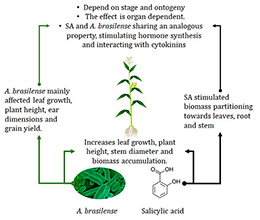Seed treatments with salicylic acid and Azospirillum brasilense enhance growth and yield of maize plants (Zea mays L.) under field conditions
DOI:
https://doi.org/10.48162/rev.39.092Keywords:
bioactive products, biofertilizers, plant hormonesAbstract

Salicylic acid and Azospirillum brasilense stimulate plant growth and productivity. In some environments, plant physiology similarly responds to both bioactive products. Considering this, a field experiment was conducted to study the physiological effect of Salicilic acid and A. brasilense on growth and grain yield of maize plants. The experiment involved three treatments consisting of imbibed seeds in an aqueous solution of SA (0.01 mM), inoculated seeds with A. brasilense and a control treatment. Seed imbibition in SA and inoculation with A. brasilense improved vegetative growth in the early stages of crop ontogeny, increasing leaf growth, plant height, stem diameter and biomass accumulation. Spikelet length and weight were greater in plants first inoculated with A. brasilense and then treated with SA. Results indicated that SA stimulated biomass partitioning towards leaves, root and stem, while A. brasilense mainly affected leaf growth, plant height, ear dimensions and grain yield. Such results turn crucial for biological fertilization strategies aimed at reducing pollutant loads that accompany chemical fertilizers. Both products can be part of maize management practices given competitive economic advantages and sustainability.
Highlights:
- Seed imbibition in SA and inoculation with brasilense improved vegetative growth in the early stages of crop ontogeny, increasing leaf growth, plant height, stem diameter and biomass accumulation.
- Salicylic Acid stimulated biomass partitioning towards leaves, root and stem in maize plants.
- Azospirillum brasilense stimulates leaf growth, plant height, as well as ear dimensions and grain yield in corn plants.

Downloads
Published
Issue
Section
License
Copyright (c) 2018 Revista de la Facultad de Ciencias Agrarias UNCuyo

This work is licensed under a Creative Commons Attribution-NonCommercial-ShareAlike 3.0 Unported License.
Aquellos autores/as que tengan publicaciones con esta revista, aceptan las Políticas Editoriales.


